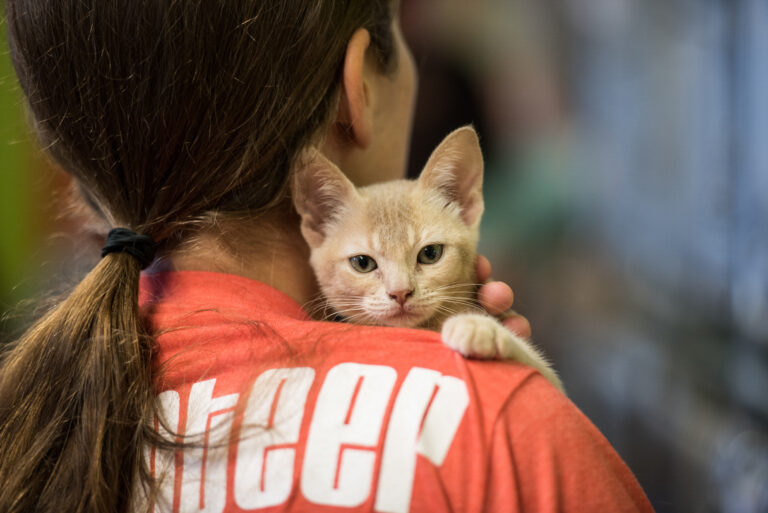Every spring, animal shelters across the country brace themselves for a familiar and overwhelming challenge—kitten season. While the term might sound adorable, it refers to the time of year when shelters experience a sudden surge in the number of kittens being brought in, often far more than they have the capacity to care for.
Understanding why kitten season occurs, what it means for shelters and the community, and how you can help can make a significant difference in the lives of these tiny felines.
Table of Contents
What is Kitten Season?
Kitten season typically begins in early spring and lasts through late summer. During this period, unspayed female cats, influenced by longer daylight hours and warmer temperatures, go into heat and begin reproducing. Because cats can breed as young as four to six months old, and female cats can have multiple litters each year, the cat population increases rapidly during these months.
Most of the kittens born during this time are from stray, feral, or unowned cats. Unfortunately, many of these litters end up in shelters, either brought in by concerned individuals or found by animal control.
Why Do So Many Kittens End Up in Shelters?
Several factors contribute to the large influx of kittens in shelters each spring:
- Uncontrolled Breeding:
Unspayed female cats can have up to three litters per year, with each litter averaging four to six kittens. Without spay/neuter programs in place or responsible pet ownership, the number of homeless kittens quickly escalates. - Feral Cat Populations:
Many feral cat colonies exist in both urban and rural areas. These cats often avoid human contact and reproduce unchecked, contributing significantly to kitten season numbers. - Surrendered Litters:
Sometimes, pet owners with unspayed cats find themselves with unexpected litters and surrender the kittens to shelters because they are unable to care for them. - Found Orphaned Kittens:
Well-meaning individuals often find abandoned or orphaned kittens and bring them to shelters, assuming it’s the best course of action.
While shelters do their best to provide care, the sheer number of kittens arriving during kitten season can strain resources, space, and staff.
The Challenges Shelters Face During Kitten Season
Kitten season presents a unique set of challenges for shelters, including:
- Overcrowding:
Most shelters are already near capacity, and the influx of kittens increases overcrowding, often forcing difficult decisions about space and care priorities. - Resource Strain:
Caring for kittens, especially newborns, requires additional time, specialized supplies, and trained staff or volunteers. Newborn kittens need to be fed every few hours, kept warm, and monitored closely for health issues. - Medical Needs:
Many kittens arrive underweight, sick, or infested with parasites. Providing proper veterinary care and vaccinations adds to the financial strain on shelters. - Difficulty in Adoption:
While kittens are generally easier to adopt than adult cats, the sheer volume means that many cats and kittens spend longer in the shelter system, waiting for homes.
How You Can Help During Kitten Season
Thankfully, there are several ways individuals can support shelters and make a difference during kitten season:
- Spay and Neuter Your Pets:
The most effective way to reduce the number of homeless kittens is through responsible pet ownership. Ensuring your cat is spayed or neutered helps prevent unintended litters. - Support Trap-Neuter-Return (TNR) Programs:
TNR programs help manage and reduce feral cat populations by trapping, sterilizing, and returning them to their colonies. Supporting or volunteering with local TNR efforts plays a critical role in breaking the cycle of overpopulation. - Foster Kittens:
Many shelters rely heavily on foster homes during kitten season. Fostering gives kittens a safe, quiet environment to grow and socialize, freeing up shelter space for other animals. - Donate Supplies or Funds:
Donations of kitten formula, food, litter, and other supplies are always appreciated. Monetary donations also help cover medical expenses and operational costs during the busy season. - Adopt a Cat or Kitten:
If you’ve been considering adopting, kitten season is a great time to give a kitten—or even better, an adult cat—a loving home. Every adoption opens up space in the shelter for more cats in need.
In Conclusion

While kitten season highlights the joys of new life, it also underscores the importance of responsible pet care and community support. The annual influx of kittens puts immense pressure on shelters, but with awareness, action, and compassion, we can all play a role in easing the burden.
Whether through fostering, adopting, donating, or spreading awareness about spay and neuter programs, your efforts can help ensure that every kitten gets the safe, loving start they deserve.







